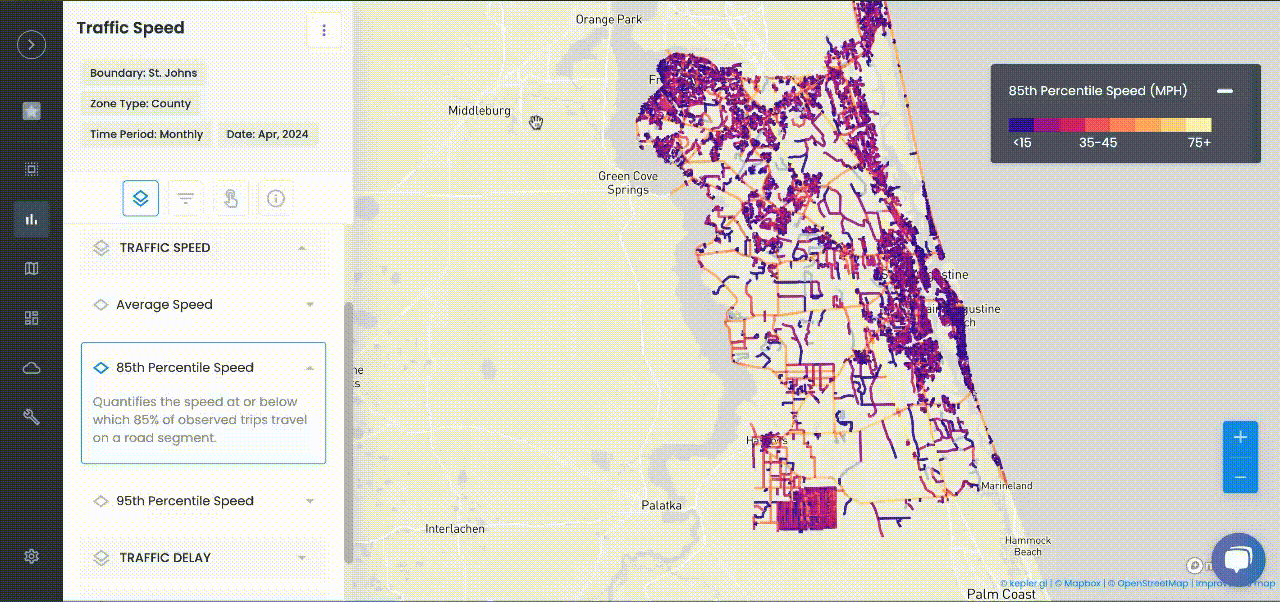
Transportation Planning
How U.S. Cities Can Use Data for Congestion Pricing
Using data to power smarter congestion pricing in U.S. cities.
Learn how U.S. cities can use traffic, demographic, and mobility data to design and manage equitable, effective congestion pricing programs.
Traffic congestion is a persistent problem in many U.S. cities, imposing costs on the economy, the environment, and public health. Gridlocked roads lead to wasted time and fuel, increased pollution, and even slower emergency response times. In fact, the impacts of traffic jams touch everything from air quality to mental health.
Data can be a powerful ally in fighting congestion — using verified data to analyze traffic trends and causes can help cities mitigate congestion’s effects. One strategy emerging in the U.S. is congestion pricing, and data-driven insights are key to making it work effectively.
What Is Congestion Pricing and How Does It Work?
Congestion pricing refers to charging drivers a fee for driving into or within certain high-traffic areas during peak times. The goal is to reduce traffic to a manageable level by encouraging some travelers to shift routes, times, or modes of transport.
Cities around the world have seen success with this approach. For example, London’s congestion charge (in place since 2003) significantly reduced downtown traffic and pollution. In the United States, researchers have long argued that pricing could help keep traffic free-flowing on overloaded roads.
Besides reducing delays, a congestion fee generates revenue that can be reinvested in public transportation and infrastructure. If structured well, these fees not only reduce traffic but also fund better travel options for everyone. It’s a two-fold benefit: fewer cars and more transportation alternatives.
New York City became the first U.S. city to implement a true congestion pricing program in early 2025. Vehicles entering Manhattan below 60th Street during peak hours now pay a variable toll based on time of day and vehicle type. Early results show downtown congestion dropped from 25% to 17%, with improved travel speeds and average trip times. NYC also collected $100 million in revenue in just the first two months – funds earmarked for public transit upgrades.
How Can Cities Use Data to Plan a Congestion Pricing Program?
For any city exploring congestion pricing, data is the foundation of effective planning. Before setting toll zones or fees, planners need a clear picture of current traffic patterns. Modern platforms like Urban SDK’s mobility data tools provide continuous data on vehicle speeds, traffic volumes, and travel times across most roadways, often sourced from GPS probes and connected vehicles.
This mobility data helps:
- Pinpoint where and when congestion is worst
- Identify peak travel periods and the most burdened corridors
- Establish a baseline of delays to set realistic improvement targets
Modeling Equity and Impact
Data can also help ensure congestion pricing is fair. For example, in Atlanta:
- Only 22% of weekday rush-hour trips on a major corridor were from city residents
- 78% were from outside the city
- 26% of trips were from households earning under $35k
- 30% were from households earning over $100k
These insights help policymakers target fees appropriately and create equity safeguards like discounts or transit investments for lower-income groups.
Key Questions Cities Must Answer Before Launching Congestion Pricing
1. Where and when is congestion worst?
Traffic speed and volume data identify the zones and time windows for charging.
2. Who are the drivers in the congested zone?
Origin-destination data reveals the share of local vs. regional commuters.
3. What are the demographics of affected travelers?
Income and household data help plan equitable pricing and discount programs.
4. Do travelers have alternatives?
Transit coverage and home-work location data identify gaps and investment needs.
5. How much revenue could be generated?
Traffic volume plus fee simulations allow for financial planning and public communication.
How Can Cities Monitor and Adjust Congestion Pricing in Real Time?
Once a program launches, cities must continue using data to operate and refine it. Real-time feeds from road sensors and GPS devices enable dynamic pricing that adapts to traffic levels.
For example:
- NYC saw 7.5% fewer cars in the toll zone within one week
- Trips across the Hudson River were 30–40% faster
- City leaders publicly shared this data to demonstrate success and adjust policy
This "deploy, measure, and adjust" model is critical. It helps cities:
- Modify fee levels based on traffic targets
- Tweak pricing zone boundaries
- Monitor enforcement accuracy (e.g. toll cameras)
- Prevent traffic diversion to nearby neighborhoods
How Can Cities Ensure Equity in Congestion Pricing?
Public support depends on fairness. Data helps:
- Identify who is most impacted by the fees
- Spot gaps in transit access
- Justify income-based discounts or targeted exemptions
- Show how funds are reinvested in vulnerable communities
New York, for example, introduced a 25% discount for low-income drivers who lack transit alternatives. These equity adjustments were based on findings from their data analysis.
What Results Should Cities Share With the Public?
Transparency drives trust. Cities should release data showing:
- Reductions in commute times
- Increases in transit ridership
- Improved air quality or reduced emissions
- Investments made with fee revenue
This data-driven storytelling makes the benefits tangible. It also helps debunk myths (e.g. that congestion pricing hurts downtown businesses or just pushes traffic elsewhere).
Why Data Is the Key to Smarter Congestion Pricing
Congestion pricing works best when powered by data – from planning to implementation to adjustment. By using real-time mobility insights, equity analysis, and traffic modeling, U.S. cities can create smarter, fairer, and more transparent programs.
With Urban SDK, city officials can:
- Set the right prices to reduce congestion
- Adjust fees dynamically based on conditions
- Monitor traffic and safety impacts
- Invest fee revenue where it’s needed most
Ultimately, congestion pricing backed by data creates cleaner, faster, and more efficient transportation systems. And when cities share the data openly, they not only gain public trust but also build momentum toward smarter, more livable communities.
FAQs
What is congestion pricing?
A system where drivers are charged a fee to enter high-traffic areas during peak times to reduce congestion and pollution.
Which U.S. city first implemented congestion pricing?
New York City introduced the first true congestion pricing plan in early 2025.
What kind of data do cities need for congestion pricing?
Traffic speed, volume, origin-destination, demographic, and transit access data.
Can congestion pricing be fair for low-income drivers?
Yes, with data insights, cities can create exemptions, discounts, or transit investments to balance the impact.
How do cities monitor congestion pricing effectiveness?Using real-time traffic data, trip speed analytics, toll system performance, and commuter behavior analysis.
FAQs
1. What is congestion pricing?
A system where drivers are charged a fee to enter high-traffic areas during peak times to reduce congestion and pollution.
2. Which U.S. city first implemented congestion pricing?
New York City introduced the first true congestion pricing plan in early 2025.
3. What kind of data do cities need for congestion pricing?
Traffic speed, volume, origin-destination, demographic, and transit access data.
4. Can congestion pricing be fair for low-income drivers?
Yes, with data insights, cities can create exemptions, discounts, or transit investments to balance the impact.
5. How do cities monitor congestion pricing effectiveness?
Using real-time traffic data, trip speed analytics, toll system performance, and commuter behavior analysis.

TRAFFIC ENFORCEMENT FEATURES
80% of citizen complaints
are a perception problem
Urban SDK provides precise hourly speed data to evaluate complaints and deploy resources efficiently for the greatest impact to public safety.
Urban SDK provides precise hourly speed data to evaluate complaints and deploy resources efficiently for the greatest impact to public safety.
Target Speeding
Identify hot spots, validate monthly speeding trends and monitor vulnerable areas like school zones.
Improve Safety
Crash and citations location information to compare speed trends month over month
Fast Response
Respond to citizen complaints sooner with address search and exportable reporting
Deploy Assets
Generate maps for traffic enforcement by time of day, location or division to deploy officers to known problem areas.
RESOURCES
Customer Success
See how public sector leaders succeed with Urban SDK.
WEBINAR
Identify speeding and proactively enforce issues
See just how quick and easy it is to identify speeding, address complaints, and deploy officers.







